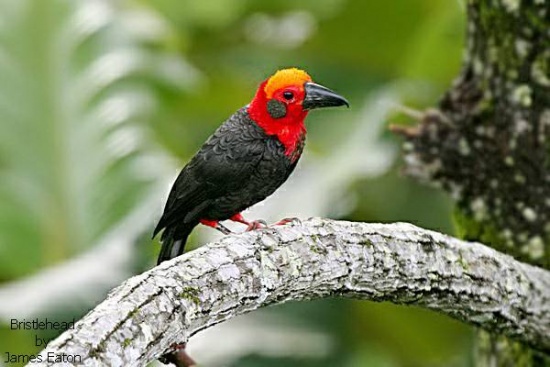
Pityriasis gymnocephala
SUBFAMILY
Pityriasinae
TAXONOMY
Barita gymnocephala Temminck, 1835, Borneo. Monotypic.
OTHER COMMON NAMES
English: Bald-headed woodshrike; French: Barite chauve; German:
Warzenkopf; Spanish: Alcaudуn de Borneo.
PHYSICAL CHARACTERISTICS
10–11 in (26–28 cm). Thickset, massive-billed, and stumpytailed.
Dusky body; black wings, tail, and bill; and red, mostly
bare head with a patch of orange-yellow stubble on the crown,
another of streaky brown over the ears, and a fringe of scarlet
feathering on upper back and breast; lower breast also covered
in bristle-like brown and red feathers. Females have a red
patch on the flanks. Eyes are chestnut and feet distinctively
yellow.
DISTRIBUTION
Lowland Borneo up to altitudes of about 3,900 ft (1,200 m).
HABITAT
Mature lowlands and swamp rainforests.
BEHAVIOR
Patchy throughout range, bristleheads appear to reside in one
area, where they work through the mid-strata of forests in
noisy groups. Little is known of their
BEHAVIOR
. They are ponderous
in movement, hopping among branches and crouching
and peering into crannies in search of food. Flight is direct, on
fast and shallowly beating wings. Calls, presumably given for
social cohesion, comprise strange nasal whines, honks, and
chortles; members of a group also will chorus, jumbling calls
loudly together.
FEEDING ECOLOGY AND DIET
Primarily predatory insectivores, gleaning gregariously among
branches and trunk crannies in forest midstage for food. Diet
comprises large insects, such as arboreal beetles, grasshoppers,
bugs, cockroaches, and larvae. Birds will also gather around recent
clearings in search of exposed food.
REPRODUCTIVE BIOLOGY
Little is understood about pair bonding and nest-building duties,
nor is the nest and its site described. Eggs are whitish,
sparingly blotched with rich brown and slate-gray mostly at the
larger end.
CONSERVATION STATUS
Listed as Near Threatened due to occurrence in mature rainforests
in areas under threat of extensive deforestation.
SIGNIFICANCE TO HUMANS
None known.
Photo Gallery of - Bornean bristlehead




 Animalia Life
Animalia Life